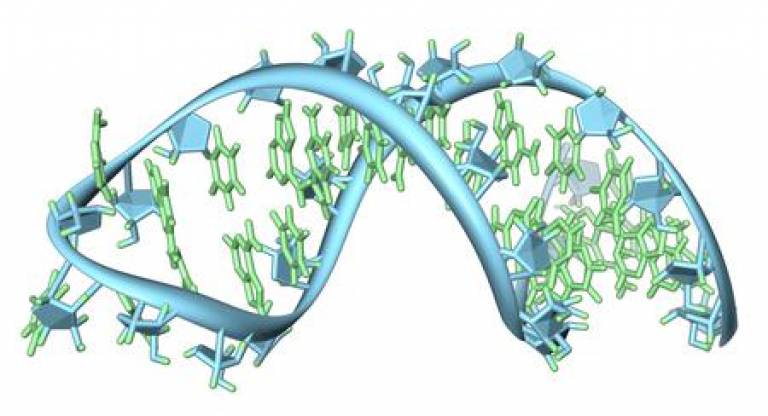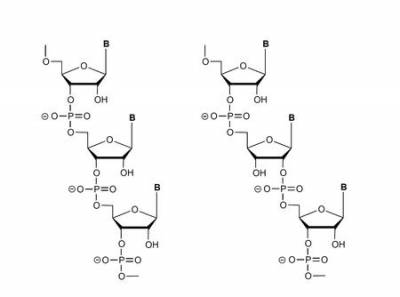New evidence points at easier start for life on Earth
14 May 2013

Just how did life on Earth begin? The precise point at which sterile chemical processes came alive is still shrouded in mystery. However, new research by Dr Matthew Powner (UCL Chemistry) and colleagues at other institutions may shed some light on how this happened.
The processes that led to the emergence of life on Earth 4 billion years ago are not at all well understood. Biochemists believe that the key moment in the formation of life on Earth was the emergence of self-replicating molecules of ribonucleic acid (RNA). Before cells formed, and long before complex organisms like humans arose, the very earliest forms of life would have simply been molecules that could replicate and transmit their structure, and RNA is the most likely candidate for this.
"The major stumbling block," Powner explains, "is how you take the simple molecules present before life emerged - something that you would call chemistry - and build the complex molecules that make up living organisms - entering the realm of biology. The same three polymeric molecules are preserved and essential across all form of life, these polymers are made of the same units and have the same basic connectivity. There is good evidence for these being present at the origins of life, and we can explain what they do - but not how you get them."
One of the three key molecules of life (alongside DNA and proteins), RNA in living organisms today is a complex family of closely-related molecules which carry and copy genetic information. Because it is both simpler and more versatile than DNA, scientists have long believed that the earliest life-forms must have consisted of little more than free-floating strands of RNA sitting in a frothy pool more than 3 billion years ago. But how this RNA could have formed and reproduced has been problematic until now.
Like DNA, RNA is a long string-like molecule, made up of a series of repeating building blocks called nucleotides, the precise order of which spell out an organism's genetic code. Unlike DNA's famous double-helix structure, RNA molecules have just one strand.
While simple RNA molecules with short chains could have arisen spontaneously out of well-understood chemical processes, which do not require any living organisms to exist, the theory hits a number of related problems at this point if we want to explain the emergence of longer, self-replicating strands that begin to look like life.
One problem relates to the structure of RNA. Every living organism on Earth has the same molecular structure in its RNA. And yet, if we replicate the conditions present on the young Earth, two different types of RNA are formed, which differ in the shape of the backbone that runs along the length of the strand. If the first long threads of RNA formed through chance collisions and combinations of molecules, it is inconceivable that it would have led to perfectly pure strands with only the structure we see in life today. How could long strands of RNA form without incorporating at least some of the 'wrong' kind of structure?

Powner and his collaborators discovered that the 'wrong' form of RNA may not actually be such a serious problem; indeed it might be a benefit in early evolution.
"First, we discovered that the two forms of RNA may not have formed in equal proportions on the young Earth. We found a process that could explain the 'right' kind of RNA being much more prevalent than the 'wrong' kind," says Powner. "Second we found that if we include up to 25% of the 'wrong' structure in strands of RNA, we still get RNA that could fulfil the functions necessary for life. This drops the hurdle and makes it much easier to explain the spontaneous formation of self-replicating RNA."
Another problem for explaining early life, is how RNA was able to replicate. In modern-day organisms, enzymes help the processes of copying genetic material, but sophisticated enzymes could not have been present on the primordial Earth. And while small RNA strands are quite easy to copy and break apart, even without the help of enzymes, this process gets harder and harder as they get longer. Powner's research suggests that the presence of a proportion of the 'wrong' type of RNA may actually have helped at this stage: incorporation some of the 'wrong' RNA would allow the formation of longer strands of RNA before they became too stable to replicate without enzymes, because it reduces the temperature at which these strands separate.
While a full understanding of how life emerged remains beyond the realms of today's science, it is no longer inconceivable. Research in this field since the mid 20th century has come forward in leaps and bounds. So could the formation of the first life forms be recreated in a lab one day?
"This is optimistic, but it's not impossible that we could do that in 20 years time," says Powner.
Notes
The research appears in two papers in the May 2013 issue of the journal Nature Chemistry:
- Prebiotically plausible oligoribonucleotide ligation facilitated by chemoselective acetylation
- Functional RNAs exhibit tolerance for non-heritable 2'-5' versus 3'5' backbone heterogeneity
Related links
- UCL Department of Chemistry
- Nature Chemistry paper: Prebiotically plausible oligoribonucleotide ligation facilitated by chemoselective acetylation
- Nature Chemistry paper: Functional RNAs exhibit tolerance for non-heritable 2'-5' versus 3'5' backbone heterogeneity
High-resolution images
Artist's impression of an RNA strand
The molecular structure of both kinds of RNA
These images can be reproduced freely providing the source is credited
Researcher profiles
Science contact
Matthew Powner
UCL Department of Chemistry
020 7679 4542
matthew.powner@ucl.ac.uk
Media contact
Oli Usher
UCL Faculty of Mathematical and Physical Sciences
020 7679 7964
o.usher@ucl.ac.uk
 Close
Close




